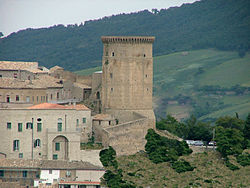Tricarico
Greek script to this article, where needed. |
You can help expand this article with text translated from the corresponding article in Italian. (January 2022) Click [show] for important translation instructions.
|
Tricarico
Trëcàrëchë (Neapolitan) | |
|---|---|
| Comune di Tricarico | |
 Norman tower and Monastery of Santa Chiara | |
UTC+2 (CEST) | |
| Postal code | 75019 |
| Dialing code | 0835 |
| Patron saint | St. Potitus |
| Saint day | 14 January |
| Website | Official website |
Tricarico (Lucano: Trëcàrëchë IPA: [trəˈkæːrəkə]; Greek: Triakrikon)[citation needed] is a town and comune in the province of Matera, Basilicata, southern Italy.
It is home to one of the best preserved medieval historical centres in Lucania.

Etymology
The origin of the name Tricarico is unknown. It might derive from the
History
Although of ancient origin, the first news documented about the town dates to 849, when it was a
In the 15th century, there was a
Main sights
This section is written like a encyclopedic style or move the content to Wikivoyage . (January 2022) |

The roads and alleys of the historical center reflect the Arabic quarters of the Ràbata and the Saracena.
Sights in the town include:
- Cathedral of the Assunta, built by Robert Guiscard. Here, in 1383, Louis I of Anjou was crowned king of Naples.
- Norman tower, with a height of 27 metres (89 ft).
- Towers of Ràbata and Saracena.
- Ducal Palace, now home to the archaeological museum
- Sanctuary of Madonna di Fonti
The archaeological area of Civita is situated outside the city. It includes a Roman fortified center that extends for approximately 50 hectares (120 acres) and consists of stone buildings with squared blocks, fortified with monumental doors. In the interior, some rooms have mosaic pavements over 2,500 years old.
Also present is the Cerra del Cedro archaeological site, inhabited from as early as the 6th century to the 3rd century BC.
References
- ^ "Superficie di Comuni Province e Regioni italiane al 9 ottobre 2011". Italian National Institute of Statistics. Retrieved 16 March 2019.
- ^ "Popolazione Residente al 1° Gennaio 2018". Italian National Institute of Statistics. Retrieved 16 March 2019.



